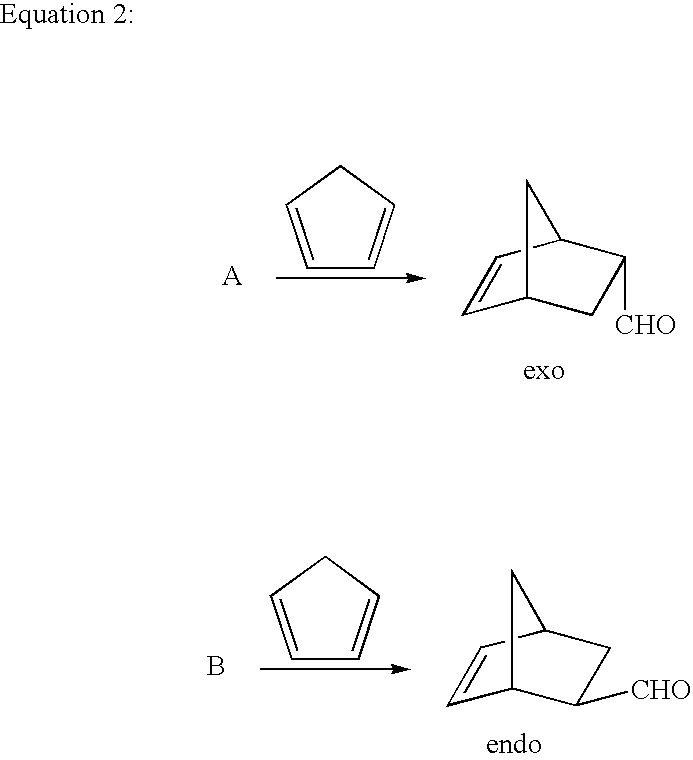Enantioselective 1,4-addition of aromatic nucleophiles to alpha,beta-unsaturated aldehydes using chiral organic catalysts
- Summary
- Abstract
- Description
- Claims
- Application Information
AI Technical Summary
Benefits of technology
Problems solved by technology
Method used
Image
Examples
example 1
[0087]This example describes the synthesis of a catalyst used in the method of the invention in two steps from phenylalanine methyl ester, according to the following scheme:
[0088]
[0089]Hydrochloride salt of (2S,5S)-5-benzyl-2-tert-butyl-3-methyllimidazolidin-4-one (1): To a solution of ethanolic MeNH2 (8.0 M, 50 ml) was added (S)-phenylalanine methyl ester (23.0 g, 130 mmol). The resulting solution was stirred at room temperature until the amino ester was judged to be consumed by TLC analysis. The resulting solution was then concentrated to provide (S)-phenylalanine N-methyl amide (18 g, 82% yield) as a white solid. To a flask containing (S)-phenylalanine N-methyl amide (8.9 g, 50 mmol) was added THF (100 ml), trimethylacetaldehyde (5.4 g, 50 mmol), FeCl3 (1.7 g, 10 mmol) and 4Å MS (5.0 g). The resulting mixture was stirred at room temperature for 36 h, then washed with H2O (3×100 mL). The combined organics were concentrated and the resulting residue was treated with HCl (27 mL, 1N ...
example 2
[0093](R)-3-(4-Dimethylamino-2-methoxy-phenyl)-butyraldehyde (Table 1, entry 1). To a 2-dram vial equipped with a magnetic stir bar was added (2S,5S)-5-benzyl-2-tert-butyl-3-methylimidazolidin-4-one (12.3 mg, 0.050 mmol, 0.100 equiv), CH2Cl2 (0.50 ml), HCl (as a 4N solution in 1,4-dioxane, 12.5 μL, 0.050 mmol, 0.100 equiv), and N,N-dimethyl-m-anisidine (73.3 μL, 0.500 mmol, 1.00 equiv). The solution was cooled to −40° C. before crotonaldehyde (124 μL, 1.50 mmol, 3.00 equiv) was added. After 36 h, the reaction mixture was subjected directly to silica gel chromatography. Elution with 20% EtOAc in hexanes followed by concentration and removal of residual crotonaldehyde under vacuum afforded the product as a colorless oil in 86% yield (94.9 mg, 0.429 mmol); 89% ee. IR (film) 2958, 2874, 2834, 2719, 1721, 1615, 1568, 1516, 1462, 1441, 1352, 1238, 1133, 1034, 979.6, 814.0 cm−1; 1H NMR (300 MHz, CDCl3) δ 9.67 (t, J=2.7 Hz, 1H, CHO), 7.03 (d, J=8.2 Hz, 1H, ArH), 6.31 (dd, J=2.5, 8.2 Hz, 1H,...
example 3
[0097](R)-3-(4-Pyrolidin-1-yl-phenyl)-butyraldehyde (Table 1, entry 2): To a 2-dram vial equipped with a magnetic stir bar was added (2S,5S)-5-benzyl-2-tert-butyl-3-methylimidazolidin-4-one (49.3 mg, 0.200 mmol, 0.200 equiv) CH2Cl2 (0.33 ml), HCl (as a 4N solution in 1,4-dioxane, 50 μL, 0.200 mmol, 0.200 equiv), and 1-phenylpyrrolidine (144 μL, 1.00 mmol, 1.00 equiv). The solution was cooled to −20° C. before crotonaldehyde (166 μL, 2.00 mmol, 2.00 equiv) was added. After 48 h, the reaction mixture was subjected directly to silica gel chromatography. Elution with 20% EtOAc in hexanes followed by concentration in vacuo and removal of residual crotonaldehyde under high vacuum afforded the product as a pale yellow oil in 70% yield (147 mg, 0.676 mmol); 87% ee. IR (film) 2962, 2927, 2829, 2717, 1721, 1616, 1522, 1372, 814.0 cm−1; 1H NMR (300 MHz, CDCl3) δ 9.71 (t, J=2.2 Hz, 1H, CHO), 7.10 (d, J=8.8 Hz, 2H, ArH), 6.54 (d, J=8.8 Hz, 2H, ArH), 3.32–3.21 (m, 5H, ArCH, N(CH2)2),2.71 (ddd, J=...
PUM
 Login to View More
Login to View More Abstract
Description
Claims
Application Information
 Login to View More
Login to View More - R&D
- Intellectual Property
- Life Sciences
- Materials
- Tech Scout
- Unparalleled Data Quality
- Higher Quality Content
- 60% Fewer Hallucinations
Browse by: Latest US Patents, China's latest patents, Technical Efficacy Thesaurus, Application Domain, Technology Topic, Popular Technical Reports.
© 2025 PatSnap. All rights reserved.Legal|Privacy policy|Modern Slavery Act Transparency Statement|Sitemap|About US| Contact US: help@patsnap.com



